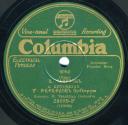 I reached out to Excavated Shellac followers on Facebook, asking for suggestions in an attempt to give myself a much-needed kick to complete a new post. One of the primary requests was string music from Iran. I decided for something in the ballpark, geographically and musically, though slightly more complicated.
I reached out to Excavated Shellac followers on Facebook, asking for suggestions in an attempt to give myself a much-needed kick to complete a new post. One of the primary requests was string music from Iran. I decided for something in the ballpark, geographically and musically, though slightly more complicated.
The artist featured here, Bala Melikyan, was an Armenian from Nagorno-Karabakh, the currently autonomous, disputed territory inside present-day Azerbaijan. Mountainous Karabakh has been a region with ethnic strife between the majority Armenians, who refer to it by the ancient name of Artsakh and are allied with Armenia, and the Azeris. The conflict dates back well over 100 years, rooted in the Bolshevik takeover of what was then known as Transcaucasia, and is something I will freely admit to being only a novice at grasping. What I can say, however, is that when it came to recording music in the Caucuasus prior to the Russian Revolution, the region was ethnically complex. Whenever a recording engineer went to Tbilisi in Georgia (considered the cultural center of the Caucasus at the time), or Baku in Azerbaijan, multiple ethnicities were recorded, and often the musicians played with each other, regardless of ethnicity. Singers commonly performed in multiple languages. This, on its own, naturally suggests deep musical ties all across the Caucasus, and of course, Iran.
Such is the case with Bala Melikyan. Born in 1888, Melikyan was a Christian Armenian from Shusha in Karabakh, a city known for its musicians who practiced the Azeri musical form known as mugham, and one of the primary cities for Armenians in the Caucasus, along with Tbilisi. His instrument was the tar, the long-necked lute of the region with a resonator that is “waisted” with an hourglass shape, traditionally is made of mulberry wood, and with three sets of double strings. Melikyan was the son of a famous tar player from Shusha known simply as Grigor (1859-1929). I’ve documented Grigor as having recorded for the Gramophone Company in at least two sessions in Tbilisi, under the names Balitka Grigor (1909) and Bala Grigorevich (1910), respectively.
Prior to the Russian Revolution (as discussed in this earlier post), the recording industry in the region was for the most part run by Europe-based multinational corporations. Even smaller labels, liked Extraphone in Kiev, who recorded in Baku, were sub-branches of European companies. After the onset of World War I and the Russian Revolution, there was a dramatic slowdown if not a full shutdown. Recording in the Caucasus and many other places under Soviet control essentially ceased after 1915 (and the 1915 sessions made by the Gramophone Company were completely lost). The industry began to pick itself up throughout the 1920s – but this time, it was governed by the State.
According to Anzor Erkomaishvili, after the Revolution there was no recording in the Caucasus until 1930*. This is one of the first – a tar improvisation by Melikyan in the Azeri mugham repertoire, in the segah mode. It was likely recorded in Tbilisi, as the flip side is from the same sessions and features a kemanche (violin) solo by Sasha Oganezashvili (1889-1932). Oganezashvili, a Georgian who was also known as Alexander Ohanyan Arshak, had actually recorded with Bala Melikyan’s father in 1909, for the Gramophone Company.
Melikyan died in 1935. This disc was issued first on the MuzTrust label, then reissued a few years later on the SovSong label. SovSong was pressed by the Aprelevka pressing plant – long before the famous and well-distributed Aprelevsky Zavod imprint of the giant Soviet recording apparatus.
Notes
Label: SovSong
Issue Number: 414
Matrix Number: 1010
*This seems to hold true. There were, however, Georgian, Armenian, and Azeri songs pressed on 78 on the Muzpred label in the mid-1920s, all performed by a man named Armenak Kahurov. It may be very likely, however, that these were all recorded in Russia.


